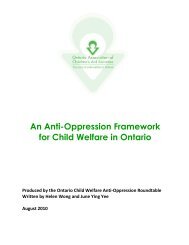English - Ontario Association of Children's Aid Societies
English - Ontario Association of Children's Aid Societies
English - Ontario Association of Children's Aid Societies
You also want an ePaper? Increase the reach of your titles
YUMPU automatically turns print PDFs into web optimized ePapers that Google loves.
LISTENING DIFFERENTLY<br />
It is important for us to prepare ourselves to be aware that when people get together<br />
to talk with one another, that each person shares their views about how they see<br />
things. It is up to each <strong>of</strong> us to respect other people’s views. Each <strong>of</strong> us interprets and<br />
understands what we hear or are taught based upon our life experiences,<br />
understanding and knowledge we each have. If we sit in a circle and listen to a story,<br />
each <strong>of</strong> us will interpret and understand the story in a way that is both the same and<br />
different as the person sitting next to us. We can talk to everyone in the circle and<br />
each person will have a different point <strong>of</strong> view. It is up to the listener to make sense <strong>of</strong><br />
what is being said, to be guided and assisted in their development toward wholeness.<br />
If we look straight ahead, we can develop tunnel vision and see things only one<br />
way. The more we listen to other people’s views, the more our vision will<br />
open up and we will start to have peripheral vision, to be able to see from all<br />
perspectives and respect those perspectives. That is what creates our wholeness, to<br />
walk in balance and harmony, to respect other people’s way, their journey <strong>of</strong> life,<br />
their way <strong>of</strong> interpreting, to treat each other with much more than kindness and<br />
respect (McCallum as cited in NAHO, 2008).<br />
CREATING A CULTURALLY SAFE ENVIRONMENT: SELF-REFLECTION<br />
Cultural safety is intended to establish a self-reflective, open-minded and nonjudgmental<br />
workforce. Through self-reflection, a child welfare pr<strong>of</strong>essional would be<br />
able to identify the values, beliefs and assumptions guiding his/her thinking. A<br />
child welfare pr<strong>of</strong>essional would be able to know that s/he is not aware, does not<br />
understand and may not even agree with an Aboriginal individual, but s/he needs<br />
to respect the individual’s views.<br />
An Aboriginal woman may not disclose violence in her family because she senses that<br />
child welfare pr<strong>of</strong>essionals will judge her as an inferior parent; in this case, the worker<br />
has not established a safe environment to help the woman address the violence that<br />
she is facing.<br />
Helping families is not simply moving children out <strong>of</strong> immediate harm’s way. Helping<br />
families means helping the family, individually and collectively, to embark on a<br />
pathway that can address and eliminate the violence in their lives. As a child welfare<br />
pr<strong>of</strong>essional, you are a key helper on the family’s journey and your individual actions<br />
can either reinforce colonial attitudes or recognize the complexity <strong>of</strong> the family’s lives.<br />
ADDRESSING PRE-JUDGMENTS AND ASSUMPTIONS: CHALLENGING OUR BIASES<br />
While it is unacceptable for a child welfare pr<strong>of</strong>essional to express a prejudicial or<br />
racist comment, workers may not recognize that some unexpressed thoughts are<br />
pre-judgments and interfere with building a relationship.<br />
Focus group participants mentioned a commonly-heard phrase which impedes the<br />
connection with a worker: “S/he does not look like an Indian.” The phrase assumes<br />
that there is a specific way that an Indian looks which challenges an individual’s<br />
95

















